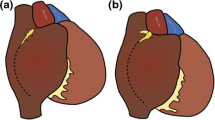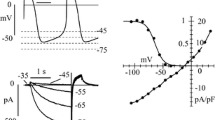Summary
The direct and indirect effects of drugs on the sinoatrial (SA) node are described in relation to basic cellular mechanisms and clinical applications. The effects of the different classes of antiarrhythmic agents are considered in terms of their direct depressant and excitatory actions. Indirect actions, particularly autonomic effects, are also discussed. Clinical aspects of the pharmacologic management of disorders of sinus node function such as the bradycardiatachycardia syndrome, inappropriate sinus tachycardia, sinus bradycardia, and the identification of sinus node dysfunction by drug effects are considered in detail.
Similar content being viewed by others
References
Brown HF. Electrophysiology of the sinoatrial node. Physiol Rev 1982; 62:505–530.
Bouman LN, Jongsma HJ. Structure and function of the sino-atrial node: A review. Eur Heart J 1986; 7:94–104.
Yanagihara K, Irisawa H. Inward current activated during hyperpolarisation in the rabbit sinoatrial node cell. Pflugers Arch 1980; 385:11–19.
Hoffman BF, Rosen MR, Wit AL. Electrophysiology and pharmacology of cardiac arrhythmias. VII. Cardiac effects of quinidine and procaine amide B. Am Heart J 1975; 90:117–122.
Goldberg D, Reiffel JA, Davis JC, et al, Electrophysiologic effects of procainamide on sinus function in patients with and without sinus node disease. Am Heart J 1982; 103:75–79.
Lippestad CT, Forfang K. Production of sinus arrest by lignocaine. Br Med J 1971; i:537.
Roos JC, Paalman ACA, Dunning AJ. Electrophysical effects of mexiletine in man. Br Heart J 1976; 38:1262–1271.
Cassagneau B, Calazel J, Bounhoure JP, et al. Electrophysiologic effects of oral encainide, with and without autonomic blockade. In: Levy S, Gerard R, eds. Recent Advances in Cardiac Arrhythmias. London: John Libbey, 1983;373.
Camm AJ. Cardiac electrophysiology of four new antiarrhythmic drugs—encainide, flecainide, lorcainide and tocainide. Eur Heart J 1984; (Suppl E):75–79.
Hellestrand KJ, Nathan AW, Bexton RS, Camm AJ. Response of an abnormal sinus node to intravenous flecainide acetate. Pacing Clin Electrophysiol 1984; 7:436–439.
Strauss HC, Gilbert M, Svenson RH, et al, Electrophysiologic effects of propranolol on sinus node function in patients with sinus node dysfunction. Circulation 1976; 54:452–459.
Narula OS, Vasquez M, Shantha N, Chuquimia R, et al. Effect of propranolol on normal and abnormal sinus node function. In: Bonke FIM, ed. The Sinus Node. Structure, Function and Clinical Relevance. The Hague: Martinus Nijhoff, 1978;112.
Yabek SM, BermanJr W, Dillon T. Electrophysiologic effects of propranolol on sinus node function in children. Am Heart J 1982; 104:612–616.
Strauss HC, Bigger JTJr. Electrophysiologic properties of the rabbit sinoatrial perinodal fibers. Circ Res 1972; 31:490–506.
Rizzon P, di Biase M, Chiddo A, et al. Electrophysiological properties of intravenous metoprolol in man. Br Heart J 1978; 40:650–655.
Greenspan AM, Spielman SR, Horowitz LN, et al. Electrophysiology of esmolol. Am J Cardiol 1985; 56:19F-24F.
Touboul P, Atallah G, Gressard A, Kirkorian G. Effects of amiodarone on sinus node in man. Br Heart J 1979; 42:573–578.
McGovern B, Garan H, Kelly E, Ruskin JN. Adverse reactions during treatment with amiodarone hydrochloride. Br Med J 1983; 287:175–180.
Antman EM, Stone Ph, Muller JE, Braunwald E. Calcium channel blocking agents in the treatment of cardiovascular disorders. Part I: Basic and clinical electrophysiological effects. Ann Intern Med 1980; 93:875–885.
Henry PD. Calcium ion (Ca++) antagonists: Mechanisms of action and clinical applications. Pract Cardiol 1979; 5:145–156.
Kass RS, Tsien RW. Multiple effects of calcium antagonists on plateau currents in cardiac Purkinje fibers. J Gen Physiol 1975; 66:169–192.
Kawai C, Konishi T, Matsuyama E, Okazaki H. Comparative effects of three calcium antagonists, diltiazem, verapamil and nifedipine, on the sinoatrial and atrioventricular nodes. Circulation 1981; 63:1035–1042.
Breithardt G, Seipel L, Wiebringhaus E. Dual effect of verapamil on sinus node function in man. In Bonke FIM, ed. The Sinus Node. Structure, Function and Clinical Relevance. The Hague: Martinus Nijhoff, 1978;129.
Padeletti L, Franchi F, Brat A, et al. The cardiac electrophysiologic effects of nifedipine. Int J Clin Pharmacol Biopharmacol 1979; 17:290–293.
Briethardt G, Seipel L, Wiebringhaus E, Loogen F. Effect of verapamil on sinus node in patients with normal and abnormal sinus node function. Circulation 1976; 54(Suppl II):19.
Imamura T, Koiwaya Y, Nakamura M. Sinoatrial block induced by oral diltiazem. Clin Cardiol 1986; 9:33–34.
Villani GQ, del Giudice S, Arruzzoli S, Dieci G. Sinoatrial block after oral administration of nifedipine. Minerva Cardioangiol 1985; 33:557–559.
Winsor T, Bleifer K, Cole S, et al. A double-blind, double cross-over trial of prenylamine in angina pectoris. Am Heart J 1971; 82:43–54.
Simoons ML, Hugenholtz PG. Haemodynamic effects of alinidine, a specific sinus node inhibitor, in patients with unstable angina or myocardial infarction. Eur Heart J 1984; 5:227–232.
Haberl R, Steinbeck G. Chronotropic action of alinidine on the isolated sinus node of the rabbit heart. Eur Hart J 1985; 6:730–736.
Millar JS, Vaughan Williams EM. Pacemaker selectivity: Influence on rabbit atria of ionic environment and of alinidine, a possible anion antagonist. Cardiovasc Res 1981; 15:335–350.
Millar JS, Vaughan Williams EM. Anion antagonism—a fifth class of antiarrhythmic action? Lancet 1981; i:1291–1293.
Nawrath H, Jochem G. On the mechanisms of the negative inotropic action of adenosine in the guinea pig heart. Naunyn-Schmiedebergs Arch Pharmacol 1982; 319:R37.
Belardinelli L, Rubio R, Berne RM. Blockade of Ca2+ dependent rat atrial slow action potentials by adenosine and lanthanum. Pflugers Arch 1979; 380:19–27.
DiMarco JP, Sellers TD, Berne RM, et al. Adenosine: Electrophysiologic effects and therapeutic use for terminating paroxysmal supraventricular tachycardia. Circulation 1983; 68:1254–1263.
Berne RM, DiMarco JP, Belardinelli L. Dromotropic effects of adenosine and adenosine antagonists in the treatment of cardiac arrhythmias involving the atrioventricular node. Circulation 1984; 69:1195–1197.
Watt AH. Hypothesis: Sick sinus syndrome: An adenosine-mediated disease. Lancet 1985; i:786–788.
Feleke E, Rydan L, Smedgard P, Westerling S. Prenalterol in symptomatic sinus node dysfunction. Am Heart J 1984; 108:185–187.
Befeler B, CastellanosJr A, Wells DE, et al. Electrophysiologic effects of the antiarrhythmic agent disopyramide phosphate. Am J Cardiol 1975; 35:282–287.
Seipel L, Breithardt G. Sinus node recovery time after disopyramide phosphate. Am J Cardiol 1976; 37:1118.
Mason JW, Winkle RA, Rider AK, et al. The electrophysiologic effects of quinidine in the transplanted human heart. J Clin Invest 1977; 59:481–489.
Chai CY, Wang HH, Hoffman BF, Wan SC. Mechanism of bradycardia induced by digitalis substances. Am J Physiol 1967; 212:26–34.
Reiffel JA, BiggerJr JT, Cramer M. Effects of digoxin on sinus nodal function before and after vagal blockade in patients with sinus nodal dysfunction. Am J Cardiol 1979; 43:983–989.
Goodman DJ, Rossen RM, Ingham R, Rider AK, Harrison DC. Sinus node function in the denervated human heart: Effect of digitalis. Br Heart J 1975; 37:612–618.
Alboni P, Shantha N, Filippi L, et al. Clinical effects of digoxin on sinus node and atrioventricular node function after pharmacologic autonomic blockade. Am Heart J 1984; 108:1255–1261.
Vera Z, Miller RR, McMillin D, Mason DT. Effects of digitalis on sinus nodal function in patients with sick sinus syndrome. Am J Cardiol 1978; 41:318–323.
Montalescot G, Levy Y, Hatt PY. Serious sinus node dysfunction caused by theraputic doses of lithium. Int J Cardiol 1984; 5:94–96.
Palileo EV, Coelho A, Westveer D, et al. Persistent sinus node dysfunction secondary to lithium therapy. Am Heart J 1983; 104:1443–1444.
Reding P, Devroede C, Barbier P. Bradycardia after cimetidine. Lancet 1977; ii:1227.
Linberger ASIII, Sprague DH, Battaglini JW. Sinus arrest associated with cimetidine. Anesth Analg 1985; 64:554–556.
Garratt C, Camm AJ. Histamine, histamine antagonists, and the human heart. Clin Prog Electrophysiol Pacing 1985; 3:419–425.
Engel TR, Luck JC. Histamine2 receptor antagonism by cimetidine and sinus node function. N Eng J Med 1979; 301:591–592.
Cayley ACD, MacPhearson A, Wedgwood J. Sinus bradycardia following treatment with hydergine for cerebrovascular insufficiency. Br Med J 1975; iv:384–385.
Flowers NC, Hand RC, Horan LG. Concentrations of fluoroalkanes associated with cardiac conduction system toxicity. Arch Environ Health 1975; 30:353–360.
Viersma JW, van den Berg MP, van Gilst WH, Lie KI. Intrinsic sympathomimetic activity (ISA) of pindolol in patients with sinus node function. Eur Heart J 1986; 7:42–46.
Tseu FI, Morley CA, Mackintosh Af. Oral xamoterol in patients with sinoatrial disease. Br Heart J 1986; 56:469–472.
Swedberg K, Hjalmarson A, Waagstein F, Wallentin I. Beneficial effects of long-term beta blockade in congestive cardiomyopathy. Br Heart J 1980; 44:117–133.
Currie PJ, Kelly MJ, McKenzie A, et al. Oral beta-adrenergic blockade with metoprolol in chronic severe dilated cardiomyopathy. J Am Coll Cardiol 1984; 3:203–209.
Vaisrub S. Da Costa syndrome revisited. JAMA 1975; 232:164.
Editorial: The sick sinus syndrome. Br Med J 1973; ii:677–678.
Benditt DG, BensonJr DW, Kreitt J, et al. Electrophysiologic effects of theophylline in young patients with recurrent symptomatic bradyarrhythmias. Am J Cardiol 1983; 52:1223–1229.
Belardinelli L, Mattos EC, Berne RM. Evidence for adenosine mediation of atriovascular block in th ischemic canine myocardium. J Clin Invest 1981; 68:195–205.
Engel TR, Leddy C, del Gonzalez A, et al. Electrophysiologic effects of hydralazine on sinoartial function in patients with sick sinus node syndrome. Am J Cardiol 1978; 41:763–769.
Gupta KP, Bhargava KP. Mechanism of tachycardia induced by intracerebroventricular injection of hydralazine (1-hydrazino-phthalazine). Arch Int Pharmacodyn Ther 1965; 155:84–89.
Franciosa JA, Pierpoint G, Cohn JN. Hemodynamic improvement after oral hydralazine in left ventricular failure. A comparison with nitroprusside infusion in 16 patients. Ann Intern Med 1977; 86:388–393.
Mond HG. The bradyarrhythmias: Current indications for permanent pacing (Part I). Pacing Clin Electrophysiol 1981; 4:432–442.
Shaw DB, Hocknell JM. Natural history of sinoatrial disorders. Clin Prog Pacing Electrophysiol 1983; 1:335–348.
Raviele A, Di Pede F, Zanocco A, et al. Valore predittivo del test all'ajmalina nelle disfunzioni del nodo del seno. G Ital Cardiol 1985; 15:751–760.
Vardas P, Travill C, Bayliss J, et al. Intravenous administration of flecainide as a stress test for syncopal patients with normal electrophysiology. Pacing Clin Electrophysiol 1987; 10:758.
Author information
Authors and Affiliations
Rights and permissions
About this article
Cite this article
Linker, N.J., Camm, A.J. Drug effects on the sinus node a clinical perspective. Cardiovasc Drug Ther 2, 165–170 (1988). https://doi.org/10.1007/BF00051231
Issue Date:
DOI: https://doi.org/10.1007/BF00051231




